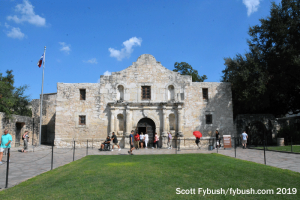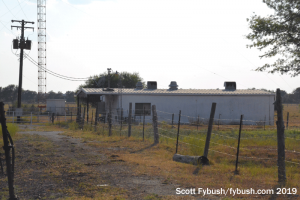NorthEast Radio Watch 12/8/2025: Cichon’s Back in Buffalo
In this week’s issue… Veteran newsman returns - Remembering NY's Leitner, RI's Jones - CT AM saved - Maine AM moves - "Indie" adds suburban signals
Text and photos by SCOTT FYBUSH
Someday, when tourism and travel once again becomes safely possible, we’ll get back on a plane – and one of the first places we hope to go is back to San Antonio. In just over a day there last September, we barely scratched the surface of all there is to see and do in this fast-growing, exciting city, especially when it comes to the downtown area.


There is, of course, the Alamo, where we made the obligatory tourist stop, made the obligatory observation that it’s much smaller than you’d expect it to be (even when you go in expecting it to be smaller than you’d think), and were especially interested in the historic preservation efforts underway to keep the building stable as it approaches the bicentennial of its big moment back in 1836.


There’s the lovely Riverwalk, which is longer than we expected – we’d love to stroll it in its entirety someday, and spend some time eating and relaxing on its banks.
And just a couple of blocks to the south, there’s the 750-foot Tower of the Americas, the most visible relic of the 1968 Hemisfair. Within a couple of years after the fair’s end, this prominent concrete pillar with its observation deck and revolving restaurant had taken on FM tenants, eventually ending up with three of them: today’s KQXT (101.9), KJXK (102.7) and KZEP (104.5).
We didn’t get up to the transmitters, but we’re told it’s a bit of an adventure – they sit up on a grid above the restaurant kitchen, carefully wedged in to a space that takes some flexibility to reach. Up above, a 98-foot mast holds the 16-bay ERI master antenna that went in back in 2007 to replace separate antennas for each of the big FMs. (It was designed, we’re told, with combiner space for a fourth FM that would have been moved in through one of those big shuffles that the FCC no longer allows.)
There are also aux antennas up on the roof, as well as a bunch of translators. (Alpha’s KTFM 94.1 feeds its HD2 to a 103.3 with throwback R&B, while its KTSA 550 feeds 107.1 up here; standards KAHL 1310 feeds a 103.7 that will eventually move to 107.9 because of an impending move-in; iHeart uses KZEP’s HD2 to feed country to a 93.3 up here and KQXT’s HD2 to feed “La Preciosa” regional Mexican to a 105.7 translator.)
If we’d known more about the history of broadcast sites in downtown San Antonio, we’d have taken a few extra minutes at this point and gone by the longtime WOAI/KMOL-TV building a few blocks away on Navarre, the site of the old KCOR/KWEX building on what’s now W. Cesar Chavez, and then picked up a few more nearby AM sites on the way out of town. But it was getting late and we had a long drive ahead of us, with some weather in the forecast, so we retrieved the rental car (it’s expensive to park down here!) and pointed it eastward on I-10 to fulfill one of the main purposes of this trip.


On the way east, out past the inner I-410 loop and just before the outer Loop 1604, we detoured just south of 10 to see another big AM, iHeart’s sports “Ticket” KTKR (760). This is a fairly new facility – it signed on only in 1984 as KSJL, paired for a time with the FM signal on 96.1 that’s now KMXX, and its four towers crank out 50 kW by day but just 1000 watts at night, protecting Detroit’s WJR.
And while KTKR (and pretty much everything else on 760) protects Detroit, everything on 1200 in North America protects the next tower on our itinerary.
WOAI was the very last of the unduplicated clear channels, holding out into the early 1980s as the only signal at night on its frequency before new 1200s hit the air in Chicago, Detroit, Boston, Ottawa, northern Virginia, Fargo and elsewhere to clutter up the channel.

It also, as it happens, was the very last of the original 25 class I-A clear channels whose transmitter site we saw and photographed, and coincidentally it took us almost exactly 25 years to complete the task. (If indeed it’s finished – we still haven’t been inside WOAI, nor WWL or WTAM, and WBBM up and moved on us, so that’s at least four more trips we could still make to truly finish the project properly.)
And this is, it must be said, not the most impressive of the I-A sites, in part because it’s also one of the newest: WOAI only moved out here to Santa Clara Road south of I-10, 20-plus miles east of downtown San Antonio, in the 1980s. The move to this 448-foot tower took WOAI off its former Franklin antenna near the Elmendorf tower farm, trading the massive skywave from that tower for a groundwave signal intended to better reach north and east up the I-35 corridor toward Austin.

There’s one more site we get to peek at as the clouds start building and the daylight begins to wane: just north of I-10 and just east of WOAI, we take a roadside look at the four-tower night array of KSLR (630).
This 4300-watt signal hit the air just before the turn of the millennium, making 630 a two-site operation and replacing a more directionally-challenged night signal from what’s still KSLR’s day site, closer to San Antonio’s east side in China Grove.
From here, it’s a long (and at points very stormy) drive east into Houston, passing through a relatively sparsely-populated landscape – though eventually we’ll return in better weather to see what there is to see of radio in places like Seguin, La Grange and Columbus.

As we announced a few weeks ago, the 2026 edition of the Tower Site Calendar will be the last.
We began publishing it 25 years ago, and the broadcast landscape is radically different now.
Radio World just ran an excellent article about us if you want to know more.
Once it’s gone, that’s it. We won’t be printing any more.
Thank you to everyone who saw our announcement and rushed to buy it. We appreciate you.
(There are some calendars from previous years if you want more of a tower photo fix — all under $5.)
But don’t wait to get this year’s Tower Site Calendar — buy it now!
We are selling the Broadcast Historian’s Calendar again this year, but we have that in an even smaller quantity — definitely don’t hesitate for that.
And visit the Fybush Media Store to check out our selection of books and videos, too!
And don’t miss a big batch of Texas IDs next Wednesday, over at our sister site, TopHour.com!
Next week: Houston – A First Look
In this week’s issue… Veteran newsman returns - Remembering NY's Leitner, RI's Jones - CT AM saved - Maine AM moves - "Indie" adds suburban signals
In this week’s issue… Scripps stations face takeover - Sinclair moves more affiliations - CT stations sold - Maine AM surrendered - Remembering WVBR's Shapiro, WABC's Morgan
In this week’s issue… CT TV legend succumbs to cancer - Remembering PA's Adams - FCC still stalled by shutdown - Pittsburgh morning host exits
In this week’s issue… FCC faces reopening challenges - Veteran Boston anchor retires - Morning shift in Toronto - NYC FMs expand reach